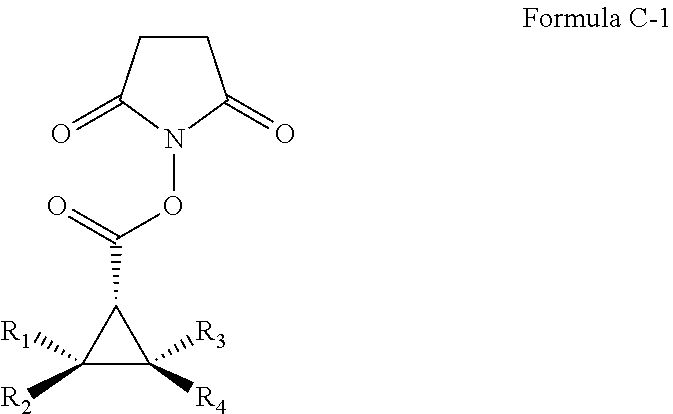Asymmetric Cobalt-Catalyzed Cyclopropanation With Succinimidyl Diazoacetate
a technology of succinimidyl diazoacetate and cyclopropaned olefin, which is applied in the direction of physical/chemical process catalysts, peptides/protein ingredients, peptides, etc., can solve the problem of low reactivity of the resulting metal-carbene intermediate, and achieve excellent diastereo- and enantioselectivities
- Summary
- Abstract
- Description
- Claims
- Application Information
AI Technical Summary
Benefits of technology
Problems solved by technology
Method used
Image
Examples
examples
[0078]General Considerations. Cyclopropanation reactions were performed under nitrogen in oven-dried glassware following standard Schlenk techniques. Toluene was distilled under nitrogen from sodium benzophenone ketyl prior to use. Succinimidyl diazoacetate was synthesized using reported literature procedure. See, for example, Blankley et al., Organic Syntheses; Wiley: New York, 1973; Collect. Vol. V, p 258.; Doyle et al., J. Org. Chem. 1996, 61, 2179.; and Ouihia et al., J. Org. Chem. 1993, 58, 1641. Olefins were purchased from commercial sources and used without further purification. Thin layer chromatography was performed on Merck TLC plates (silica gel 60 F254). Flash column chromatography was performed with Merck silica gel (60 Å, 230-400 mesh, 32-63 μm). 1H NMR and 13C NMR were recorded on a Varian Inova400 (400 MHz) with chemical shifts reported relative to residual solvent. Infrared spectra were measured with a Nicolet Avatar 320 spectrometer with a Smart Miracle accessory. ...
PUM
| Property | Measurement | Unit |
|---|---|---|
| enantiomeric excess | aaaaa | aaaaa |
| flow rate | aaaaa | aaaaa |
| particle size | aaaaa | aaaaa |
Abstract
Description
Claims
Application Information
 Login to View More
Login to View More - R&D
- Intellectual Property
- Life Sciences
- Materials
- Tech Scout
- Unparalleled Data Quality
- Higher Quality Content
- 60% Fewer Hallucinations
Browse by: Latest US Patents, China's latest patents, Technical Efficacy Thesaurus, Application Domain, Technology Topic, Popular Technical Reports.
© 2025 PatSnap. All rights reserved.Legal|Privacy policy|Modern Slavery Act Transparency Statement|Sitemap|About US| Contact US: help@patsnap.com



